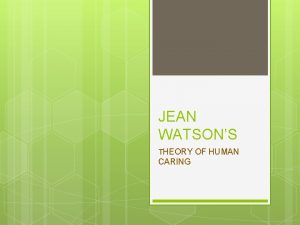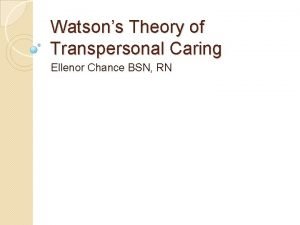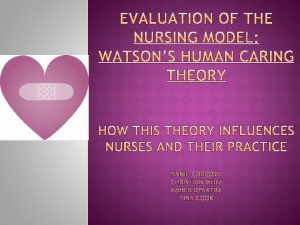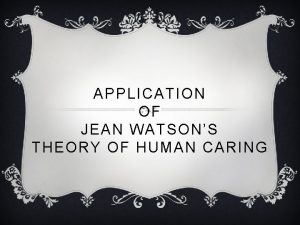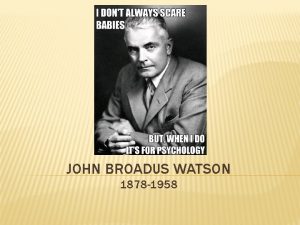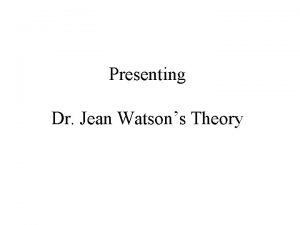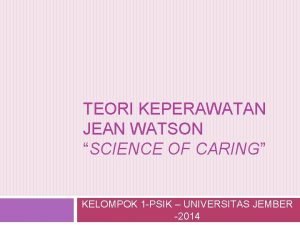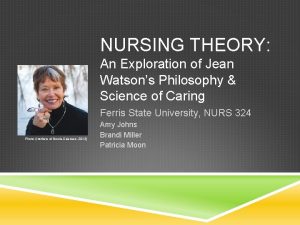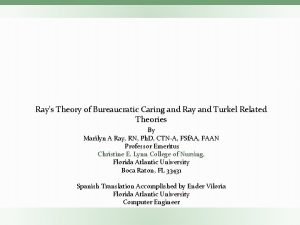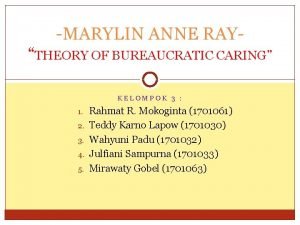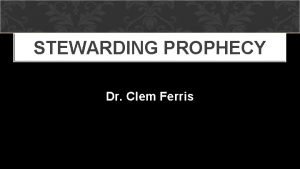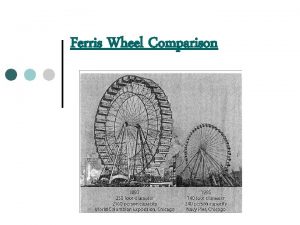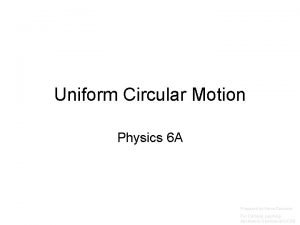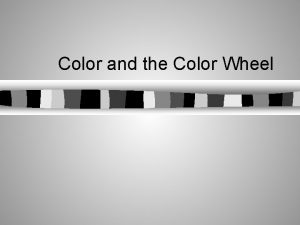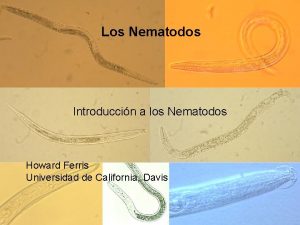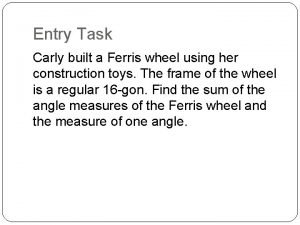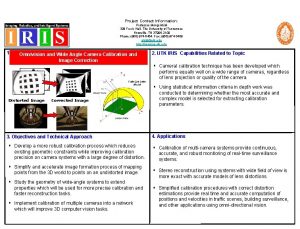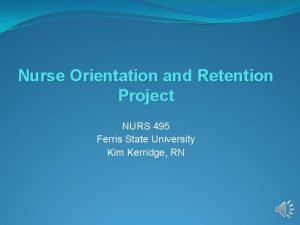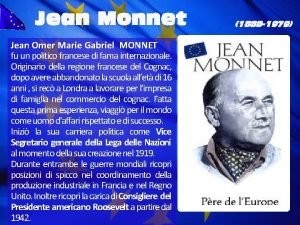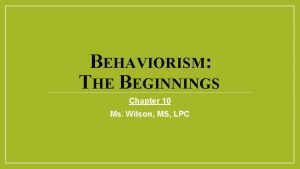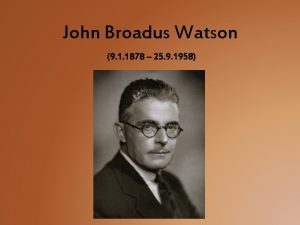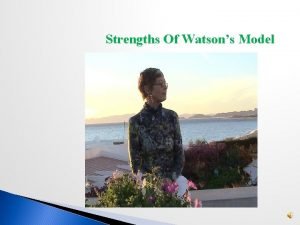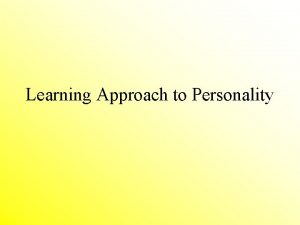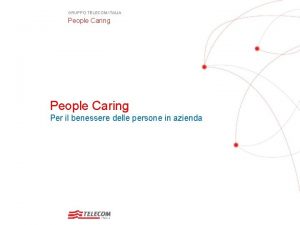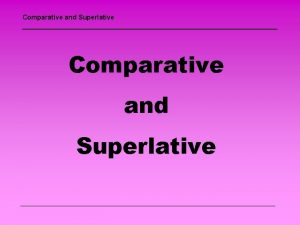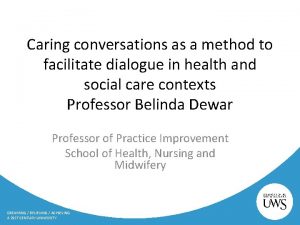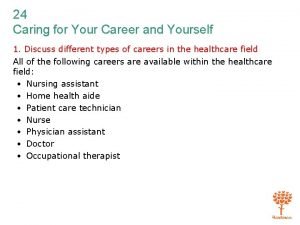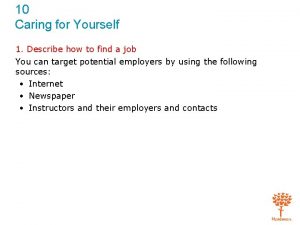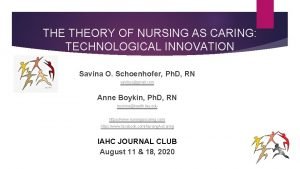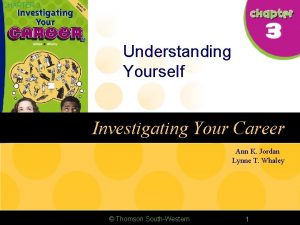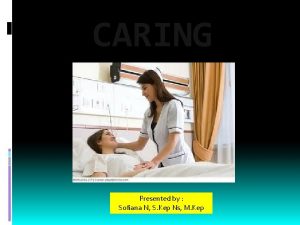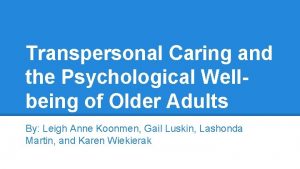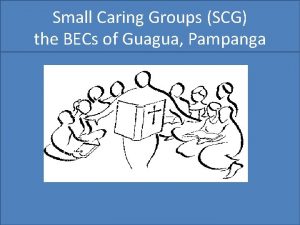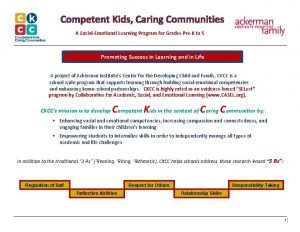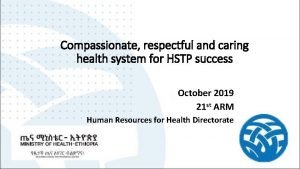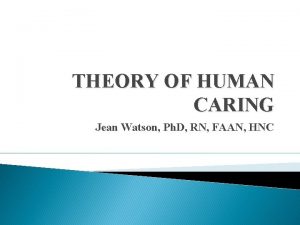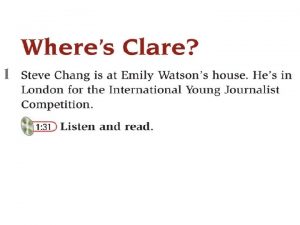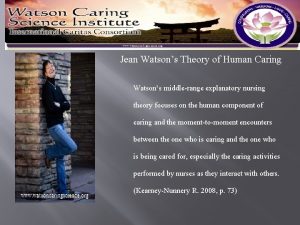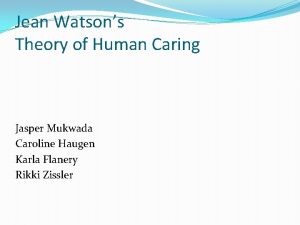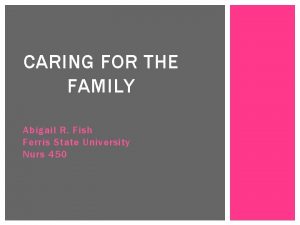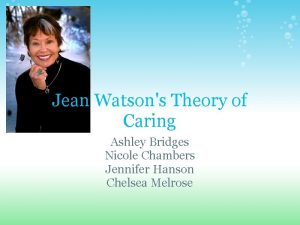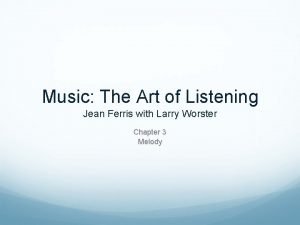Dr Jean Watson Theory Of Human Caring Ferris






























































- Slides: 62

Dr Jean Watson: Theory Of Human Caring Ferris State University Mary Haverty-Robinson. RN OCN Patricia Kraemer. MCHRN Angie Robl MSRN Marianna Burns CGERN Nadezhda Litton RN 1

Medicine and Health in the 1970’s Spring 1971 A committee of the US Senate identified five problems in the health care system: 1. Maldistributions and shortage of health manpower; 2. Inequality in health care and inequality in access to health care including financing; 3. Rising costs; 4. Too little attention paid to keeping people well; 5. Lack of coordination in the health-care system, resulting in waste and duplication. Baughman, Bondi, Layman, Mc. Connell, & Tompkins, 2001 2

Nursing in the 1970’s �Increase in autonomy and increase in decisionmaking responsibilities �Increased level of education to college-level degree in nursing �Women’s movement influencing the roles between doctors and nurses Baughman, Bondi, Layman, Mc. Connell, & Tompkins, 2001 3

Watch a nurse that doesn’t use the “Watson Way’! Starring…. . 4

Please follow link to video http: //www. youtube. com/watch? v=Fr 9 TFb. E_13 o&featur e=email 5

The conception of the Theory Human Caring �During the turmoil of the 1970’s the Theory of Human Caring was developed by Dr. Jean Watson. �Developed between 1975 -1979 by Jean Watson while she was involved in her doctoral studies in educational-clinical and social psychology. Watson, 2007 6

Dr Jean Watson Ph. D, RN, AHN-BC, FAAN �RN Diploma in nursing �B. S. in nursing �M. S. psychiatric mental-health nursing Minor: psychology �Graduate study: Social and Clinical psychology �Ph. D Educational Psychology and Counseling 7

The Theory of Human Caring was Dr. Watson’s first attempt to “bring meaning and focus to nursing as an emerging discipline and distinct health profession with its own unique values, knowledge and practices, with its own ethics and mission to society…. to find common meaning and order to nursing that transcended settings, populations, specialty, subspecialty areas, and so forth. ” Watson, 2007 8

Jean Watson’s responses to changing medicine �“ The current dilemmas in health care often located within a framework that emphasizes the outer forces of economics, staffing shortages, and technological - medical issues, or system/institutional needs ” (Watson, 2004 b, p. 249). �This disconnection between the current focus in addressing health care issues conflicts with and greatly differs from the deeply human-to-human caring relationships and human-to-human connections that give meaning and purpose to nurses, patients, and other health practitioners alike. 9

The Theory of Human Caring Unique Concepts of the Theory of Human Caring �Transpersonal caring relationship �Caring occasion/caring moment �Clinical Caritas Process Kearney, 2008 10

Transpersonal Caring Relationship �“The human-to-human connectedness” �“A high regard for the whole person and his or her being-in-the-world. ” Kearney, 2008 11

Caring Occasion/Caring Moment “A caring occasion occurs whenever the nurse and another come together with their unique life histories and phenomenal fields in a human-to-human transactions…the actual caring occasion has a greater field of its own in a given moment. ” Watson, 2007 12

The Theory of Human Caring Originally theory was organized by a framework of “carative factors”. However, recently this has evolved in to “clinical caritas” and “caritas processes” Watson, 2007 13

Evolution of the Theory of Human Caring Carative Factors Clinical Caritas Processes �Formation of humanisticaltruistic system of values 1. ) Practices of loving-kindness and equanimity within context of caring consciousness 2. ) Being authentically present and enabling and sustaining the deep belief system and subjective life world of self and one-being-cared-for �Instillation of faith-hope 14

Evolution of the Theory of Human Caring Carative Factors Clinical Caritas Processes �Cultivation of sensitivity to one’s self and to others 3. ) Cultivation of one’s own spiritual practices and transpersonal self, going beyond ego self 4. )Developing and sustaining a helping-trusting, authentic caring relationship �Development of a helpingtrusting, human caring relationship 15

Evolution of the Theory of Human Caring Carative Factors Clinical Caritas Processes �Promotion and acceptance of 5. ) Being present to, and the expression of positive and supportive of the expression negative feelings of positive and negative feelings as a connection with deeper spirit of self and the one-being-cared-for 6. )Creative use of self and all �Systematic use of a creative ways of knowing as part of problem-solving caringthe caring process: to engage process, in artistry of caring-healing practices 16

Evolution of the Theory of Human Caring Carative Factors Clinical Caritas Processes � Promotion of transpersonal teaching-learning 7. )Engaging in genuine teachinglearning experience that attends to unity of being and meaning attempting to stay within other’s frame of reference 8. )Creating healing environment at all levels physical as well as non-physical, subtle environment of energy and consciousness, whereby wholeness, beauty, comfort, dignity and peace are potentiated � Provision for a supportive, protective, and /or corrective mental, physical, societal, and spiritual environment 17

Evolution of the Theory of Human Caring Carative Factors Clinical Caritas Processes � Assistance with gratification of human needs 9. ) Assisting with basic needs, with an intentional caring consciousness, administering “human care essentials: which potentiate alignment of mindbody-spirit, wholeness, and unity of being in all aspects of care 10. ) Opening and attending to spiritual-mysterious and existential dimensions of one’s own life-death: soul care for self and one-being-care-for � Tending to both embodied spirit and evolving spiritual emergence; allowance for existential-phenomenologicalspiritual forces 18

Evolution of the Theory of Human Caring The evolution of Jean Watson and her theory is challenging a paradigm shift in the culture of nursing to a more spiritual and loving focus. Watson, 2007 19

Metaparadigms 20

PERSON: A human being has needs (biophysical, psychophysical, psychosocial and intrapersonal) that are to be valued, respected, supported and cared for. 21

ENVIRONMENT: The environment should be conducive to holistic healing (mentally, physically, socially, spiritually) as it is critical to the patients well being. 22

HEALTH: Health is viewed in a holistic approach; it is being able to function mentally, physically, spiritually, and socially to your full capacity. 23

NURSING: The contact and the bond between two individuals is the foundation of nursing. 24

Watson’s Practice Methodology Requirements: �Transpersonal Caring Relationships �Authentic Presencing 25

26 Transpersonal Caring Relationships

The Nurse Sees: � Everyone as unique and whole �Not defined by illness or disease 27

The Nurse: Actively engages in the well being of her patient. 28

The nurse is aware of the unity of mind body spirit 29

The nurse also has a: Spiritual connection awareness 30

The nurse sees that: Caritas lead to natural healing. 31

The Nurse: Utilizes various elements to promote healing. 32

Authentic Presencing intentionality energy mutuality Authentically present growth authenticity 33

The Nurse : � Is not distracted � Is focused 34

The authentically present nurse: �Sees through the eyes of the patient �Wants to make a difference �Promotes calmness 35

NURSING EDUCATION BEYOND CARING CARITAS 36

Watch how Watson's model can be used as a framework for patient assessment Nursing the “Watson Way”…. . 37

Please Follow Link � http: //www. youtube. com/watch? v=Fr 9 TFb. E_ 13 o&feature=email 38

Current Research Status 39

Caring Relationship Improves recovery from depression Improves patient outcomes Improves quality of life Improves perceived quality of care 40

“…In trying to measure caring, one is drawn into a process of reducing a complex subjective, intersubjective, relational, often private, and invisible human phenomenon to a level of objectivity that…trivialize, and dilutes its authenticity and deeper meaning”. Watson, 2009 41

Current Difficulties “. . The abstractness of the concept and the clinical reality in some situations…has limited the development of a knowledge base in Watson’s caring theory…” Alligood, 2006, p. 102 42

Caring Assessment Tools 1. CARE-Q 2. CARE/SAT 3. CBI 4. PCB 5. Care Efficacy Scale 6. Caring Factor Survey 43

Caring Relationship General feeling of wellbeing Psycho-social development Development of support system Development of appropriate coping mechanisms Self-expression Promotes: 44

Limitations of Watson's Theory 45

“… the congruence between… the values and major concepts and beliefs in the model and the given nurse, group, system, organization, curriculum, population needs, clinical administrative setting, or other entity that is considering interacting with the caring model to transform and/or improve practice. ” Watson, 1996 46

The spiritual aspects are difficult for some to relate to. 47

Some situations in the clinical setting do not lend themselves to practicing her theory. 48

Is it feasible to “let go” of your concerns and thoughts about other clients while being with this particular one? phones Call bells Critical labs Overload 49

� “I consider my work more of a philosophical, ethical, intellectual blueprint for nursing’s evolving disciplinary/professional matrix rather than a specific theory per se” Watson, 1996 50

Strengths Of Watson’s Model

Watson’s model acts as a stimulus to examine what it means to care 52

Her theory can bring a new facet or dimension to the individual nurses’ practice and can be a model of potential and goal attainment of institutions 53

Self Identified Strengths 54

Final Analysis : Dr. Jean Watsons’ Theory of Human Caring 55

Caritas Caring Occasion Nurse Patient Transpersonal Caring Relationship Transcendence Harmony Healing 56

nurse patient Healing 57

Existence The Soul Spiritual Human Dimension of 58

REFERENCES Alligood, M. R. , & Tomey, A. M. (2006). Nursing Theorist and their Work (6 thed. ). St. Louis, MO: Mosby. Baughman, J. , Bondi, V. , Layman, R. , Mc. Connell, T. , & Tompkins, V. (Ed. ). (2001). Nursing in transition. American decades (Vol. 8). Detroit: Gale. Retrieved from http: //0 go. galgroup. com. libcat. ferris. edu/ps/start. do? p=GVRL&u=lom_ferrissu Baughman, J. , Bondi, V. , Layman, R. , Mc. Connell, T. , & Tompkins, V. (Ed. ). (2001). The 1970’s: Medicine and health: Overview. American decades (Vol. 8). Detroit: Gale. Retrieved from http: //0 -go. galgroup. com. libcat. ferris. edu/ps/start. do? p=GVRL&u=lom_ferrissu Clarke, A. , Hanson, E. J. , Ross, H. (2003). Seeing the person behind the patient: Enhancing the care of older people using a biographical approach. Journal of Clinical Nursing. 12, 697 -706. Erci, B. , Sayan, A. , Kilic, D. , Sahin, O. , & Gungormus, Z. (2003). The effectiveness of Watson’s caring model on the quality of life and blood pressure of patients with hypertension. Journal of Advanced Nursing. 2, 130 -139. Kearney-Nunnery, R. (2008). Advancing your career; Concepts of professional nursing (4 th ed. ). Philadelphia, PA: Davis. 59

Mullaney, J. A. B. (2000). The lived experience of using Watson’s actual caring occasion to treat depressed woman. Journal of Holistic Nursing. 2, 129 -142. Persksy, G. J. , Nelson, J. W. , Watson, J. , & Bent, K. (2008). Creating a profile of a nurse effective in caring. Nursing Administration Quarterly. 1, 15 -20. Sitzman, K. , & Eichelberger, L. W. (2004). Understanding the work of nurse theorist. Sudsbury, MA: Jones and Bartlett. Swanson , K. (1999). What Is Known About Caring in Nursing Science: A Literature Meta -analysis. ” In A. S. Hinshaw, S. Feetham, & J. Shaver (Eds. ). Handbook of Clinical Nursing Research (pp. 31 -60). Thousand Oaks, CA: Sage. Watson, J. (1979). Nursing: The Philosophy and Science of Caring. Boston, MA: Little Brown. Watson, J. (1985). Nursing: Human Science and Human Care- Theory of Nursing. Boston, MA: Jones & Bartlett. Watson, J. (1996). Watson’s theory of transpersonal caring. Boulder, CO: University Press of Colorado. Watson, J. (2005). Caring Science as Sacred Science. Philadelphia, PA: F. A. Davis. 60

Watson, J. (2006). Caring theory as an ethical guide to administrative and clinical practices. Nursing Administration Quarterly. 1, 48 -55. Watson, J. (2007). Theory of Human Caring. Retrieved from http: //hschealth. uchsc. edu/son/faculty/caring. htm Watson, J. (2007). Transpersonal caring and the caring moment defined. Retrieved from University of Colorado Denver College of Nursing website: http: //www. nursing. ucdenver. edu/faculty/jw_evolution. htm Watson, J. (2008). Nursing: The Philosophy and Science of Caring. (2 nd ed. ) Boulder, CO: University Press of Colorado. Watson, J. (2009). Caring: Theory evolution. Retrieved from University of Colorado Denver College of Nursing website: http: //www. nursing. ucdenver. edu/faculty/jw_evolution. htm 61

Thank You! 62
 Jean watson theory of caring diagram
Jean watson theory of caring diagram Theory of transpersonal caring
Theory of transpersonal caring Caring is the essence of nursing jean watson
Caring is the essence of nursing jean watson Maybe this one moment with this one person
Maybe this one moment with this one person Jean watson theory
Jean watson theory Advance nursing concept
Advance nursing concept Purpose of jean watson's theory
Purpose of jean watson's theory James broadus watson
James broadus watson John broadus watson emma watson
John broadus watson emma watson John b. watson emma watson
John b. watson emma watson John b. watson emma watson
John b. watson emma watson Emma watson nurse
Emma watson nurse Jean watson's conceptual model
Jean watson's conceptual model Jean harman watson
Jean harman watson Teori keperawatan madeleine leininger
Teori keperawatan madeleine leininger Teori jean watson
Teori jean watson Jean watson's philosophy of nursing
Jean watson's philosophy of nursing Jean watson 10 carative factors
Jean watson 10 carative factors What is the theory of bureaucratic caring
What is the theory of bureaucratic caring Anne boykin y savina o. schoenhofer
Anne boykin y savina o. schoenhofer Teori marilyn anne ray
Teori marilyn anne ray Wage a good warfare with the prophecy
Wage a good warfare with the prophecy Ferris wheel comparison
Ferris wheel comparison Mip ferris
Mip ferris A ferris wheel with a radius of 14m
A ferris wheel with a radius of 14m Michael himawan ferris wheel
Michael himawan ferris wheel John ferris virginia tech
John ferris virginia tech Ferris bueller teacher gif
Ferris bueller teacher gif Acuity ferris wheel
Acuity ferris wheel Odontoestilete
Odontoestilete Karen ferris glasgow
Karen ferris glasgow Connie ferris bailey
Connie ferris bailey Ferris wheel task
Ferris wheel task Ferris hall utk
Ferris hall utk Ferris orientation
Ferris orientation Jean omer marie gabriel monnet
Jean omer marie gabriel monnet Jean monnet jean-gabriel monnet
Jean monnet jean-gabriel monnet Methods of behaviorism
Methods of behaviorism John b watson theory
John b watson theory Ivan pavlov theory
Ivan pavlov theory John watson
John watson Watsons model
Watsons model Watson theory of personality
Watson theory of personality Sharing is caring meaning
Sharing is caring meaning People caring telecom italia
People caring telecom italia Unusual superlative
Unusual superlative Key club cnh
Key club cnh Caring for life cipla
Caring for life cipla Chapter 21 caring for head and spine injuries
Chapter 21 caring for head and spine injuries Caring to change
Caring to change Caring conversations framework
Caring conversations framework Chapter 31 caring for your career and yourself
Chapter 31 caring for your career and yourself Cna chapter 10 exam
Cna chapter 10 exam Afida membuat bangun dengan cara
Afida membuat bangun dengan cara We are caring
We are caring Dance of caring persons
Dance of caring persons Chapter 24 caring for your career and yourself
Chapter 24 caring for your career and yourself Teori caring menurut mayehoff
Teori caring menurut mayehoff Transpersonal caring moment
Transpersonal caring moment Small caring group
Small caring group Mobile team challenge
Mobile team challenge Competent kids, caring communities
Competent kids, caring communities Compassionate respectful and caring
Compassionate respectful and caring
